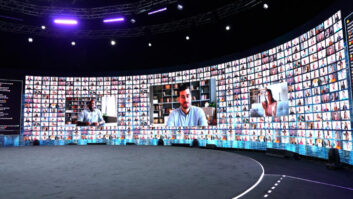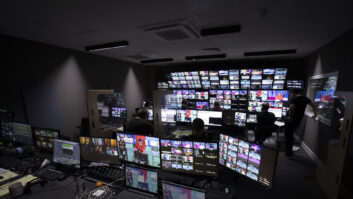
Previously we looked at how the broadcast and AV worlds are drawing ever closer, and that both industries are also aware of the advantages offered by IT. Here Ian McMurray considers the growing demand for broadcast-quality technology in live event settings, and the opportunity presented by the integration of IPTV and digital signage.
“Video consumption is on the rise in just about every market sector we look at,” says Will Waters, director of product marketing for NewTek. “Video is becoming a significant method for standard communication within facilities of all sizes, and is shaping the way that we communicate in businesses, schools, houses of worship, government and legislative bodies, to name a few. It is now possible for even a small company to produce their video messages and distribute them to their employees over reasonably priced off-the-shelf networking gear and use standard desktops or mobile devices as displays.”
A sector that seldom crosses the radar of the average European integrator, but that has always been a significant AV opportunity in North America, is churches.
“In the house of worship market, having high-quality broadcast technology is less critical, but that’s changing with the continued growth of mega churches that also offer access to their services online, “says Bryce Button, director of product marketing, AJA Video Systems. “When services are streamed, although latency is not as big of an issue, good picture quality is still valued. Furthermore, church attendees on-site are also increasingly expecting a broadcast-quality experience from the screens in the venue and on many occasions for displays in rooms and areas outside of the main hall.”
It’s not just about fixed, in-house installations however, as Button points out. “Right now, in the pro AV market, we’re seeing a growing demand for broadcast-quality video/audio technology in live event settings from music concerts to sporting events,” he says. “In sizeable event venues, such as stadiums or concert halls, broadcast equipment is driving digital imagery on large screens, bringing the audience a more compelling experience. We’re also seeing an ever-increasing demand for high quality videoconferencing solutions in business environments, especially for live presentations with multiple camera streams and video channels that run at HD and UltraHD.”
Richer experience
Craig Heffernan, technical sales manager at Blackmagic Design too notes significant interest from the rental/staging market, with Blackmagic’s broadcast video technology used to cover sports, live performances or staged events with video content being used to provide a richer audience experience.
Although a broad range of industries and organisations are starting to see that not only is video distribution desirable, but also practicable and affordable, their requirements are, according to Keen, often not very different.
“All environments have similar service requirements,” he believes. “There may just be a difference in the way they determine success or failure of a project. In smaller sports teams they may look at ROI, increases in sales, advertising revenues and spectator numbers – while in an enterprise environment, they will look at system uptime, increases in concurrent streams and system reliability as their yardstick. Uniform across both, though, is that these systems become mission critical – so they need good support services following the sale.”
Waters takes a similar view. “All markets have their specific requirements,” he claims. “Facilities that provide entertainment, such as sporting arenas, are very concerned about the quality and look of the video to grab and keep the attention of the viewer – but higher resolutions and deep colours take up more bandwidth and increase cost. The HR director who needs to communicate new policies quickly may be more concerned about the hard costs of the components and, since they have a captive audience, may look for a value-engineered system.”
Universal requirements
Reliable, high-quality technology with ease of use and set-up and low cost of maintenance are, says Heffernan, universal requirements.
“This doesn’t change whether we’re working with a national broadcaster or a local education authority,” he declares. “While a broadcaster, or even a large live sports or music event, may have a more complex solution with multiple cameras requiring larger-scale distribution and production switching, the definition of the needs and selecting the right products for managing sources, distribution, monitoring and output can be the same.
“As an additional requirement, a broadcaster will want to ensure they have full redundancy in any system, as they cannot send black frames to air,” he continues, “while an AV customer wouldn’t require the expense of redundancy. That customer will, however, have more of a demand for flexible and adaptable solutions, perhaps with greater support for legacy hardware or use with analogue or standard definition platforms.”
For Colin Farquhar, CEO at Exterity, the big opportunity for organisations – regardless of whether they’re sports venues, hotels/leisure facilities, corporate office or schools/universities – is the integration of IPTV with digital signage to create a single, unified communications channel.
“Broadcast video, when integrated with digital signage, is a fundamental ingredient to achieving effective communications,” he believes. “As AV/IT convergence continues apace, digital signage has become a key component in delivering internal communications as a natural companion to an IP video system. The integration of digital signage and IP video specifically enables administrators to manage their communications systems seamlessly, to ensure the right content is being displayed on the right screens and to the right people within the organisation.”
Indresovde believes there are similarities – and differences.
“Whatever the business sector, the primary concerns are the same: cost, quality, and futureproofing,” he says. “The secondary concerns, however, can vary greatly. Anything having to do with government will be concerned with security and any vulnerability to confidential information. Areas such as hospitality and education are more concerned with cost and ease of operation to reduce the amount of training required for the end users.”
www.aja.com
www.blackmagicdesign.com
www.exterity.com
www.newtek.com







